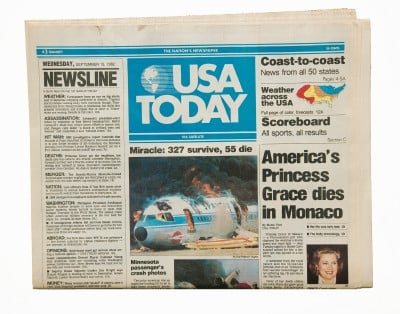By David Colton
It isn’t often that the President of the United States comes to your birthday party and disses you, but that’s pretty much what happened at USA Today’s fifth anniversary in September 1987.
Founder Al Neuharth wasn’t going to let critics or millions of dollars in losses spoil his dream of a national newspaper. So he beamed when Ronald Reagan visited USA Today’s Rosslyn headquarters for an anniversary reception.
The President punctuated his remarks by saying, “I even understand that the Pulitzer board may change its award criteria because of USA Today and recognize the most creative news paragraph.”
It was a variation on an inside joke and got a laugh, but editors winced. What did we have to do to get some respect?
I was Washington editor then and knew only too well that for all our colorful charts, snazzy layouts, and national reach, we had yet to earn street cred. Our stories were too short, and one headline summed up our frothy approach to the news: men, women: we’re still different.
We sometimes went to bizarre lengths to stand out. When Reagan gave a speech saying that even Albert Einstein needed help with the tax code, the staff was asked to find out who had done Einstein’s taxes.
Despite calls across many time zones, we never found out. The incident became newsroom lore—until 2006, when a copyeditor found a Web site revealing that in 1938 Einstein had given a telescope as a gift to Leo Mattersdorf, “his tax accountant and personal friend.”
“This is wonderful!” wrote Nancy Monaghan, the editor who had asked the question. “Now if someone could figure out why it took the crack staff at USAT some 20 years to get the answer!”
USA Today was part of a media shock wave in the 1980s. Along with CNN, C-Span, MTV, ESPN, and Entertainment Tonight, a national newspaper delivered by satellite to printing plants all over the country represented a threat to traditional newspapers. It took 11 years, but in 1993 USA Today hit a daily circulation of 2 million and started to make a healthy profit. It’s now the nation’s biggest-selling paper.
By the 1990s, stories were getting longer, resources were plentiful, and you were guaranteed that your story would be read by colleagues on the campaign trail. They had little choice—the paper was dropped at their hotel-room door every morning.
More than a dozen reporters and photographers went to the Gulf War in 1991, a seasoning of the staff that deepened their reporting. Washington bureau chief Susan Page remembers thinking on arriving in 1995 that “people who worked here didn’t realize how much better the paper had gotten.”
Through the 2000 presidential recount, 9/11, Hurricane Katrina, and the Iraq War, USA Today has tried to make a mark as a go-to paper and Web site for major events. The newspaper devoted almost four pages this summer to why the Pentagon delayed sending safer vehicles to US troops in Iraq.
This month, USA Today at 25 is thriving. Circulation and advertising are steady while other newspapers are struggling.
Then–Washington Post executive editor Ben Bradlee said during the start-up years that “if USA Today is a good newspaper, I’m in the wrong business.” True, that was part of his feud with Neuharth, but it was also a stinging rebuke from someone who’d helped inspire a generation of journalists.
“It was just some wiseass remark,” Bradlee told me this year. “I wish I’d learn to shut up. I don’t feel badly about the paper at all. If I get the hell out of a big city, I am so glad for USA Today that I can’t stand it.”
For all its gains, USA Today’s reputation as a breezy read is hard to escape. And why should we want to? At speaking engagements, I still use my reliable opening line: “I’m from USA Today, so I’ll be brief.”
David Colton is USA Today’s page-one editor. He wrote the afterword for an updated edition of The Making of McPaper: The Inside Story of How USA Today Made It, published this month.



















